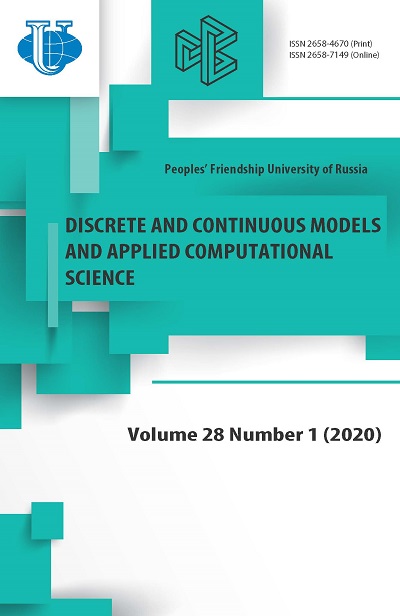Vol 28, No 1 (2020)
- Year: 2020
- Articles: 5
- URL: https://journals.rudn.ru/miph/issue/view/1326
- DOI: https://doi.org/10.22363/2658-4670-2020-28-1
Full Issue
Computer Science
Verification of a labor market domain using an academic crowdsourcing system
Abstract
Students desiring to become a valuable good in the labor market are willing to pay a considerable monetary cost to obtain knowledge about their prospective job opportunities, nowadays with a diminishing interest in the obtainment of a diploma. Considering the behavior of the labor market as a domain theory under uncertainty, it is straightforward to expect the presence of contradictions, in the form of salaries unable to be classified due to high inconsistency and variation. We provide an algorithm to verify a labor market domain theory based on a crowdsourcing academic system, in which feedback about possible contradictions is generated as a result of consultations with experts inside of the market and clustered into different contexts. We found that the verification process can be repeated iteratively as long as the students’ overall tuition is equal or greater than a quantity partially defined by the number of different profiles of the students.
 5-16
5-16


Modeling and Simulation
Numerical determination of the singularity order of a system of differential equations
Abstract
We consider moving singular points of systems of ordinary differential equations. A review of Painlevé’s results on the algebraicity of these points and their relation to the Marchuk problem of determining the position and order of moving singularities by means of finite difference method is carried out. We present an implementation of a numerical method for solving this problem, proposed by N. N. Kalitkin and A. Al’shina (2005) based on the Rosenbrock complex scheme in the Sage computer algebra system, the package CROS for Sage. The main functions of this package are described and numerical examples of usage are presented for each of them. To verify the method, computer experiments are executed (1) with equations possessing the Painlevé property, for which the orders are expected to be integer; (2) dynamic Calogero system. This system, well-known as a nontrivial example of a completely integrable Hamiltonian system, in the present context is interesting due to the fact that coordinates and momenta are algebraic functions of time, and the orders of moving branching points can be calculated explicitly. Numerical experiments revealed that the applicability conditions of the method require additional stipulations related to the elimination of superconvergence points.
 17-34
17-34


Simulation of non-stationary event flow with a nested stationary component
Abstract
A method for constructing an ensemble of time series trajectories with a nonstationary flow of events and a non-stationary empirical distribution of the values of the observed random variable is described. We consider a special model that is similar in properties to some real processes, such as changes in the price of a financial instrument on the exchange. It is assumed that a random process is represented as an attachment of two processes - stationary and non-stationary. That is, the length of a series of elements in the sequence of the most likely event (the most likely price change in the sequence of transactions) forms a non-stationary time series, and the length of a series of other events is a stationary random process. It is considered that the flow of events is non-stationary Poisson process. A software package that solves the problem of modeling an ensemble of trajectories of an observed random variable is described. Both the values of a random variable and the time of occurrence of the event are modeled. An example of practical application of the model is given.
 35-48
35-48


Two-way communication retrial queue with unreliable server and multiple types of outgoing calls
Abstract
Retrial queue under consideration is the model of call center operator switching between input and outgoing calls. Incoming calls form a Poisson point process. Upon arrival, an incoming call occupies the server for an exponentially distributed service time if the server is idle. If the server if busy, an incoming call joins the orbit to make a delay before the next attempt to take the server. The probability distribution of the length of delay is an exponential distribution. Otherwise, the server makes outgoing calls in its idle time. There are multiple types of outgoing calls in the system. Outgoing call rates are different for each type of outgoing call. Durations of different types of outgoing calls follow distinct exponential distributions. Unsteadiness is that the server crashes after an exponentially distributed time and needs recovery. The rates of breakdowns and restorations are different and depend on server state. Our contribution is to obtain the probability distribution of the number of calls in the orbit under high rate of making outgoing calls limit condition. Based on the obtained asymptotics, we have built the approximations of the probability distribution of the number of calls in the orbit.
 49-61
49-61


Calculation of the normal modes of closed waveguides
Abstract
The aim of the work is the development of numerical methods for solving waveguiding problems of the theory of waveguides, as well as their implementation in the form of software packages focused on a wide range of practical problems from the classical issues of microwave transmission to the design of optical waveguides and sensors. At the same time, we strive for ease of implementation of the developed methods in computer algebra systems (Maple, Sage) or in software oriented to the finite element method (FreeFem++). The work uses the representation of electromagnetic fields in a waveguide using four potentials. These potentials do not reduce the number of sought functions, but even in the case when the dielectric permittivity and magnetic permeability are described by discontinuous functions, they turn out to be quite smooth functions. A simple check of the operability of programs by calculating the normal modes of a hollow waveguide is made. It is shown that the relative error in the calculation of the first 10 normal modes does not exceed 4%. These results indicate the efficiency of the method proposed in this article.
 62-76
62-76
















